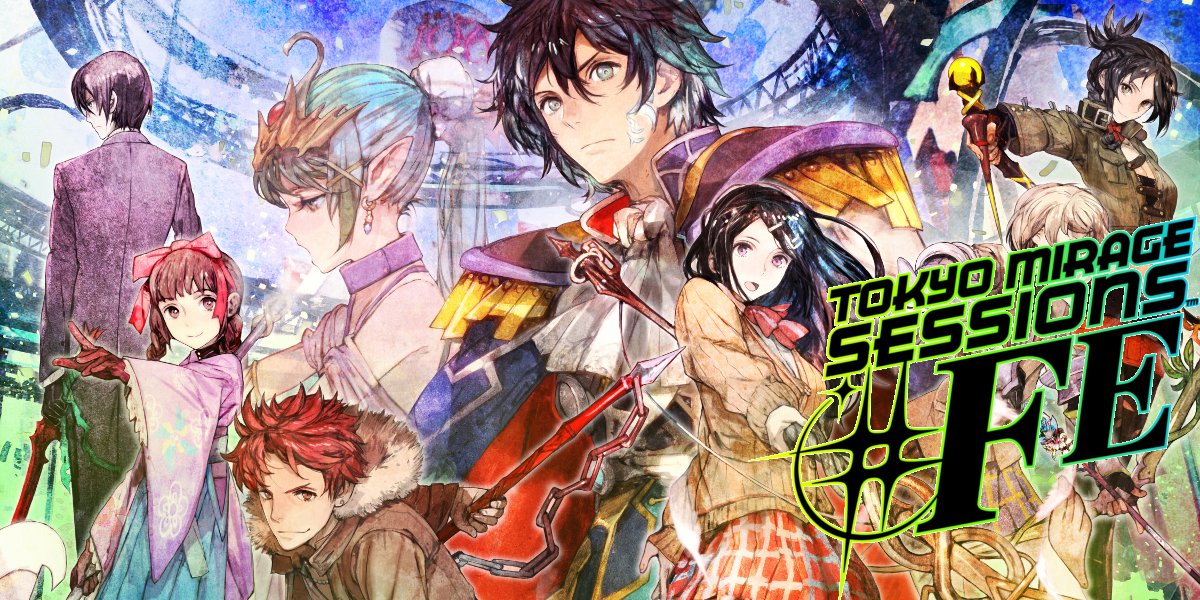It should say something about the origins of this game that it was originally titled Shin Megami Tensei x Fire Emblem; it’s got a new name now, but Tokyo Mirage Sessions #FE (pronounced “Sharp FE”) is still a Shin Megami Tensei (or as the fans call it, Megaten) game underneath. I’ve been a huge fan of the Megaten series for years, so I was looking very much forward to getting my hands on Tokyo Mirage Sessions #FE to see what it was about.
Unlike prior Megaten games where the protagonist is nameless with personality to match, the hero of Tokyo Mirage Sessions #FE is an 18 year old kid by the name of Itsuki Aoi. After saving an old childhood friend, Tsubasa Oribe, from creatures from another plane of existence (called the Idolasphere), he awakens a power within himself to fight off the shadow creatures from there. The power, in the form of an avatar from the Fire Emblem series, helps him and his friends to try and understand what the creatures are, and what they want with highly-talented singers and performers.

Like Shin Megami Tensei but…
Tokyo Mirage Sessions #FE, while a Megaten game, plays a lot more like the Digital Devil Saga games in the series rather than the main numbered Megaten games or the Persona series. If you’ve no idea what any of this means, let me explain. Shin Megami Tensei is a JRPG series where the protagonists don’t generally do all the fighting themselves, but rather harness the power of alternate beings to help them battle whatever it is they’re fighting. In Shin Megami Tensei, it’s angels and demons from various bits of lore. In Persona, they’re called Persona, even though they serve the same purpose. In both Digital Devil Saga and Tokyo Mirage Sessions #FE, the alternate beings manifest as part of the hero. In Tokyo Mirage Sessions #FE, these beings are called Mirages, and are from the Fire Emblem universe (specifically from Fire Emblem Awakening and Fire Emblem: Shadow Dragon and the Blade of Light. Sadly, no Fire Emblem Fates characters). During battle, these avatars take an alternate form called a Carnage; for example, Chrom, Itsuki’s Mirage, takes the form of a sword during battle, and can ostensibly be said to be doing the actual fighting, even though Itsuki is holding it.

The game’s story centers very heavily around Japan’s idol industry, a concept that can take an entire article to explain, although you can read this AV Club primer to get a small insight into what it’s all about without being overwhelmed. Tokyo Mirage Sessions #FE’s characters are soon inducted as idols to make it easier for them to track down evil mirages, and they become employees of Fortuna Entertainment, a front for a team of elite mirage-hunters. The exploration of the characters’ side stories has a lot to do with them aspiring to, and working towards becoming idols, while the sections in between deal with hunting these baddies down through the Idolasphere. The conceit of the characters being performers extends throughout the game: in the main menu, they’re called the cast, and checking on character stats must be done through the “Casting” menu. Costume and weapon changes? That’s Wardrobe. The selected characters? Main cast. Even battles are assumed to be a performance of sorts, with the battle taking place on an elaborate stage arena with hundreds of audience members around you cheering the battle on. If you perform a special ability in battle, your characters don’t just draw any random sigil, they actually write their autograph. I loved these little touches of detail.

Battle it out
The battle system is something any Megaten player will be highly familiar with: it’s a turn-based affair with you directly controlling the party’s actions (or letting the CPU control your allies). If an attack hits a weak spot, your allies can automatically chain attacks without using a turn, and these chains are called Session attacks. Like other Megaten games, every foe has a weak spot or two, and though you need to find the weak spot on your own the first time you fight the enemy, it’s thankfully documented on screen every subsequent time. I liked not having to remember which enemy was weak to what because it streamlined the battles. Outside of battle, when exploring the Idolasphere, enemies are depicted as red-cowled spirits (much like the shadows from Persona), and hitting one of them before they hit you nets you a first strike–essentially an extra turn against the foe.
While not exploring dungeons in the Idolasphere (which, thankfully, don’t change every time like they do in Persona), you can explore certain regions of Tokyo, such as the famous Shibuya Crossing or Harajuku. The depictions of these locations in the game are fairly close to the reality of Tokyo. For example, in the game, there’s a massive coffee shop across from the train station. In reality, it’s a huge Starbucks. Or the famous Shibuya 109 department store is rebranded in this game as Shibuya 106. Not subtle by any means, but it gives the location an air of legitimacy. Sadly, you’re limited to a certain space within each region, so it’s not as sandboxy as I’d had liked; the fun is in exploring the Idolasphere after all. I was impressed with the level of detail, though, down to a duty-free store down one of the avenues.

Graphically, the game is loud and colourful, and highly reminiscent of Persona 4’s art style. The game pops with stars and sparks, and positively squeaks with Japanese kawaii-ness. One detail I loved was that nonessential NPCs were just coloured shapes with no detail, allowing you to pick out quite quickly which person you wanted to talk to, while giving the game an air of busy-ness with a lived-in feeling.
Voicing concerns
Tokyo Mirage Sessions #FE is fully voiced in Japanese, and there’s going to be a lot of division about this decision. Certainly, all the important bits are properly subtitled, so you don’t lose any of the story, but then there are many un-subtitled sections, such as the banter during fights. My Japanese was adequate enough to piece together what the characters were saying, but for many players it’s not going to add anything to the experience; if anything, it might have an excluding effect. On the other hand, I can certainly understand Atlus’s reason for not dubbing the game. American voice actors are notoriously bad at translating the feel of Japanese without sounding cheesy. Furthermore, the voice artists in Japan were all singers in their own right as well, and they’d need English-speaking actors who are also talented singers to carry the game properly, given the amount of music. But I really think more subtitles would have helped a little. If you’re a fan of Japanese pop music, you’re going to love the game’s soundtrack; I always hope that Japanese pop breaks out of the geek-niche that it lives in in the west, and we can see if it does for this game. I’m not holding out hope, but the soundtrack definitely is fantastic.

Aside from the appearance of the characters from Fire Emblem, Tokyo Mirage Sessions #FE has very little in common with Fire Emblem, which may disappoint fans of that series. Sure, it has the weapon “rock-paper-scissors” mechanic, but it’s not as overt or as pronounced as in Fire Emblem. It’s most definitely far more a Megaten game, but it’s also not a clear part of the series. You’ll see nods to it here and there; for example, the skill names are precisely those used in Megaten games, so fans of that series will already be familiar with what obscurely-named skill does what. Other nods include seeing Persona here and there (for example, Jack Frost is the mascot for Hee-Ho mart), indicating that the game definitely takes place in the Persona universe somehow. I’ll leave it up to other theorists to figure out the precise details.
To conclude…
Personally, I thoroughly enjoyed the game as a “Megaten Lite” experience. The focus was far more on the characters and their stories than on the action, but then there was plenty of that to keep me busy, too. The music and colour made for a loud, vivid game that felt very strongly of the Japanese idol scene (see any music video from AKB-48 if you want to get more of a feel for it). I do wonder if the huge cultural differences in the game might alienate some players, although it’s definitely a good way to get the feel for modern Japanese culture while playing. In terms of gameplay, it fills the hole left by Persona 4 while I wait for Persona 5 to arrive, and while it lacks the strategic depth of Fire Emblem, it still made for a compelling, enjoyable JRPG.



